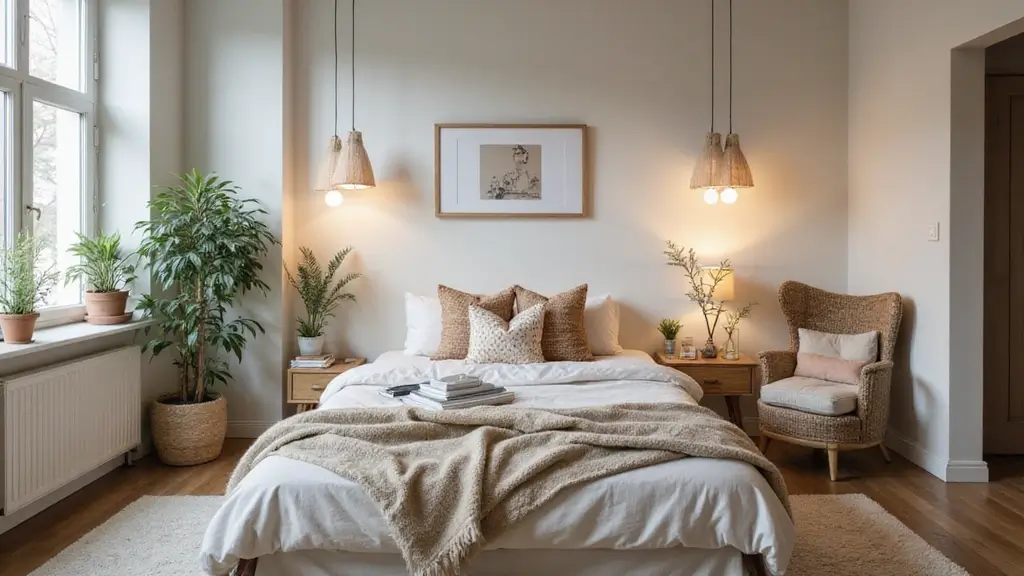I put this together because many adults share a bedroom and still want it to feel calm, not cramped. The room should be a place to rest, recharge, and feel safe. I want to help you turn a shared space into something that feels balanced and cozy.
If you share a bed with a partner, live with a roommate, or turn a guest room into a daily space, this guide is for you. You care about privacy, easy upkeep, and a bedroom that still reflects your style. This post speaks to adults who want calm, practical design that fits real life.
Inside you’ll find 25 shared bedroom ideas for adults that feel balanced and cozy. These tips cover layout, color palettes, textures, storage hacks, lighting, and privacy tricks. They’re practical, affordable, and simple to test in a weekend.
Here is why these ideas work. They create zones for sleep, work, and storage without making the room feel crowded. You’ll see ideas like beds with built-in storage, movable screens for privacy, soft textiles, and warm lighting. Each idea comes with a quick, doable step so you can start today.
Not every tip fits every space. If your room is tiny, pick one style and one or two pieces that support it. If you have more space, you can mix textures and colors while keeping a calm base. The goal is balance, not clutter.
Next steps are simple. Start by measuring the room, then choose a style that suits your needs. Decide which zones you need: sleep, storage, and a small desk or charging nook, and pick two ideas to try first. That way you test what works without overhauling the room.
Read on to see the full set of ideas and practical steps you can apply this week. You’ll end with a room that feels warm, organized, and truly yours, even when sharing the space with another adult.
1. Harmonious Color Palette
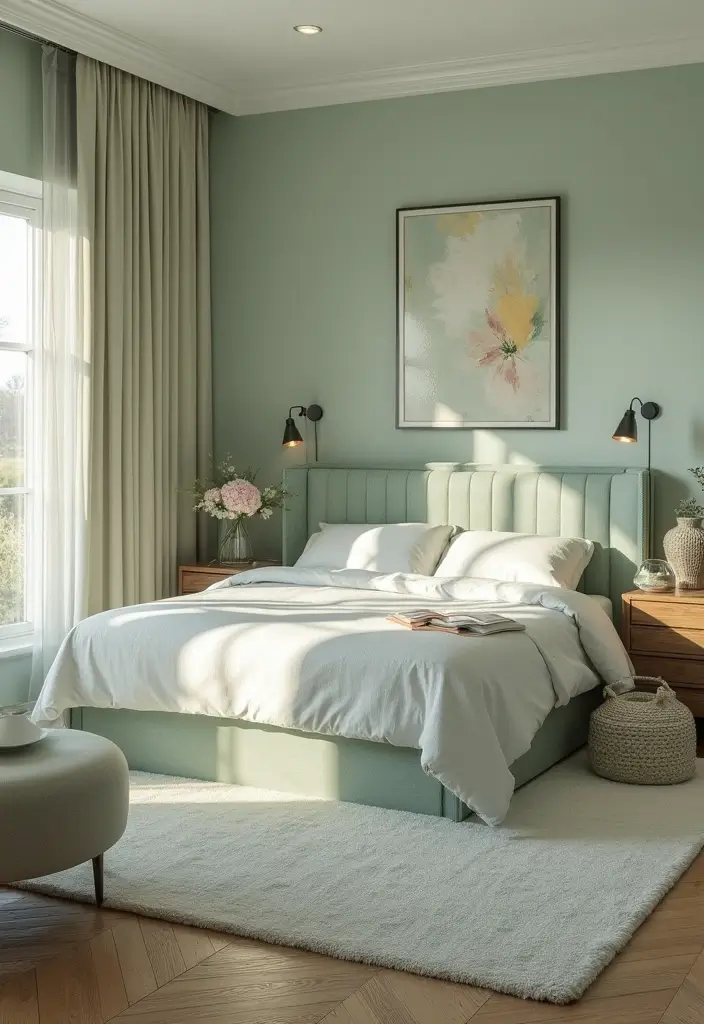
You want a shared bedroom that feels calm to both of you. Start with a quiet base. Neutral tones like soft white, warm gray, and muted green set a soothing stage.
Add accents that reflect your memories. A touch of color gives personality without shouting.
Use color swatches to test balance. Hold samples near bedding, furniture, and wall space. See how light changes them through the day.
Soft pastels bring serenity. Deeper shades add warmth and intimacy. The goal is a space where both can breathe easy and feel connected.
– Calming colors to consider: beige, soft blue, pale yellow
– Textures you can touch: linen curtains, a chunky knit throw, cotton sheets
– Art that reflects both of you, tying the room together
How to put it into practice:
– Choose three colors: a base, a secondary, and a single accent
– Pick textiles in those colors to layer the room
– Bring in art and accessories that balance both tastes
Next steps: test in real life, not just on a swatch. Observe in morning light and at night, adjust as needed.
Watch how natural light shifts tones. In the evening, colors warm up. If a shade feels off, swap fabric or add texture.
2. Multifunctional Furniture

Sharing a bedroom with another person means you need space that feels calm, not crowded. Multifunctional furniture helps you keep the room balanced and cozy. You get more floor space and less clutter when one piece does two jobs.
Here is how to use these ideas in a real room:
– Bed with built-in storage Under the bed, drawers hold sheets, blankets, and off-season clothes. The drawers glide smoothly, so they stay quiet at night. This keeps a dresser free for other things.
– Ottoman or storage bench A single bench seats you and hides stuff inside. Choose a fabric that hides dust. A small tray on top holds a lamp.
– Fold-out desk A desk that folds away lets you work when you need it and vanish. Pick a slim chair that tucks under the table.
– Wall-mounted shelves Save floor space. Use them for books, plants, or bins.
– Decorative baskets Baskets blend with your decor and hold remotes, chargers, and magazines. Pick a few sizes for different uses.
Next steps: measure your space, pick one two-use piece to start, and test the feel. Take a week to test the setup and adjust as you go. Small tweaks can make a big difference. This setup stays easy to change as your needs shift.
3. Layered Textures
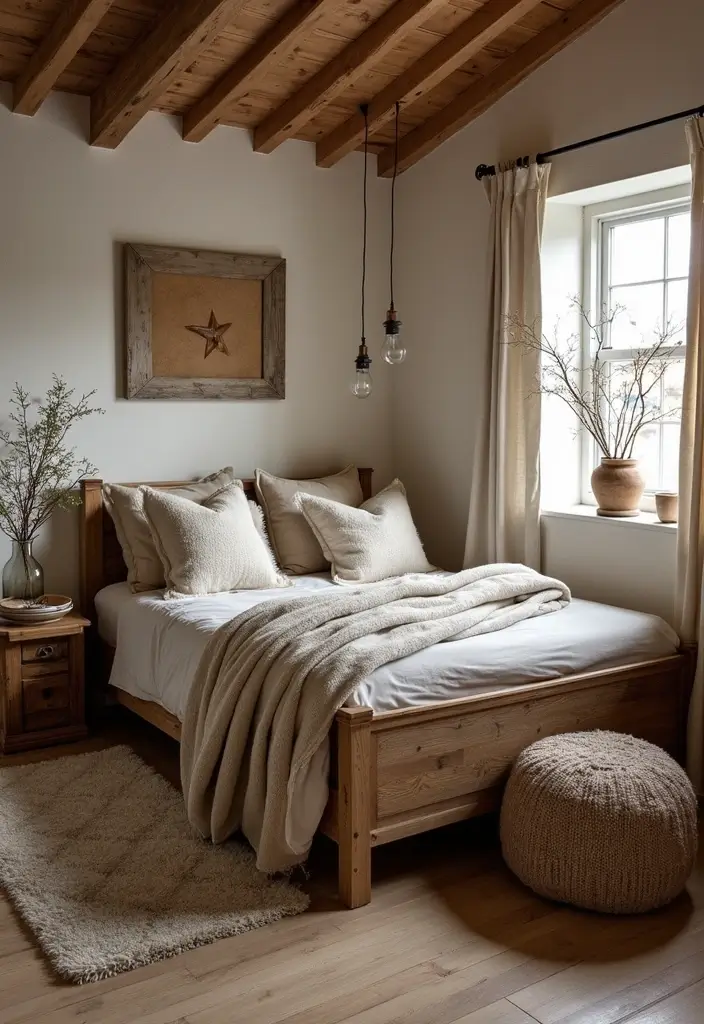
If your shared bedroom feels dull, layered textures can bring it to life. They add warmth and balance, so both of you feel comfortable.
Here is why textures matter. They catch light in different ways and create depth. Mixing soft and rough surfaces helps a space look inviting, not flat. Texture also helps hide little wear and makes everyday scenes feel cozy.
– Bedding mix: Start with your bed. Use a cotton sheet set under a light quilt. Drape a chunky knit throw at the foot for warmth and bite. The different fabrics invite you to touch and relax.
– Textured accents: Add pillows in linen, knit, and a touch of faux fur. Put 3 or 4 different textures on the bed or a chair. Keep colors quiet so the mix feels calm, not chaotic.
– Grounding layers: Place a plush area rug under the bed or at the foot. A jute rug brings warmth and a natural feel. It also softens steps and lowers noise.
– Furniture and lighting: Pick wooden nightstands or a slim wood bench. Soft, warm lighting makes textures pop and creates a snug mood. Aim for bulbs that give off a cozy glow.
– Maintenance note: Choose fabrics that you can wash easily. Check care labels and pick durable textures. This keeps the room looking fresh without extra work.
Next steps: test one or two texture ideas this week, then add a third. You’ll feel the space become more balanced and inviting.
4. Shared Wall Art
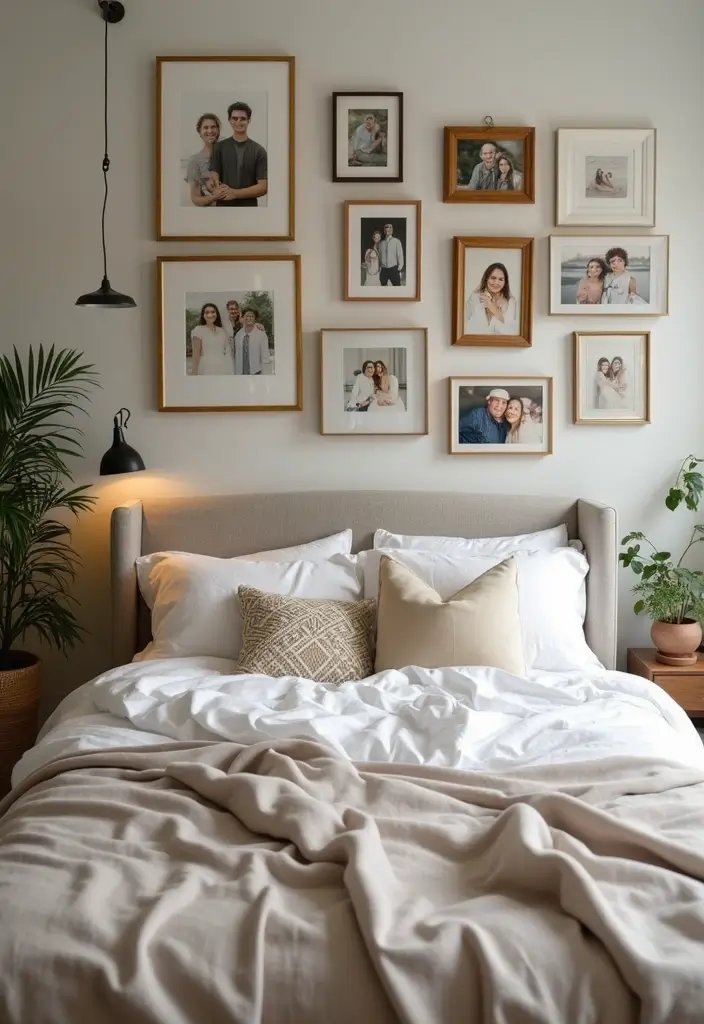
Your shared bedroom should feel calm and fair. Wall art is a simple way to make that happen. It can show both of you without leaning too far in one direction. Here is why a mixed gallery works.
– Create a gallery that tells your story. Use photos, small prints, and a piece of personal art. Plan on the floor first, then hang to match your layout.
– Pick frames that link your look. Use the same color or finish on all frames to tie pieces together. Let each piece stay bold in its own right.
– Mix styles and sizes. Try wood and metal finishes. Include big and small frames for balance. This keeps the wall lively without shouting.
– Add meaning with quotes or lyrics. Short lines in simple fonts feel friendly. Include a favorite lyric or a note from a trip.
– Rotate art through the year. Swap in new pieces for spring and fall. Store old pieces in a portfolio or box.
Practical setup tips. Measure the wall, cut paper templates, and test layout with painter’s tape. Hang at eye level for comfort.
Next steps: plan, gather, and start small. A thoughtful wall can make both of you feel at home.
5. Soft Lighting Solutions
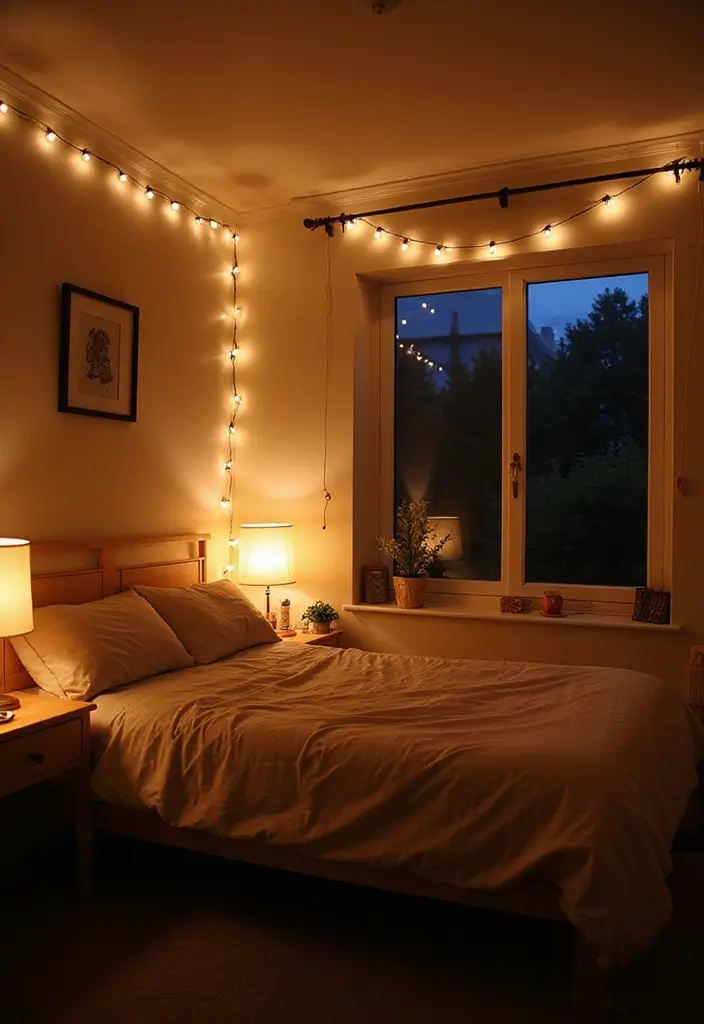
In a shared bedroom, soft lighting changes the whole feel. It makes the space calm, balanced, and cozy. You get a room that supports rest and time together. Start with layered light. Skip bright overheads. Use several gentle sources that blend glow.
– Bedside lamps with diffused shades. Place one on each nightstand. A warm glow on both sides keeps the room even. Choose bulbs around 2700K and add a dimmer for easy control.
– Fairy lights or string lights. Drape them around a headboard, along a wall, or above a window. They add a soft halo without glare.
– Smart bulbs and color options. Change brightness fast. Switch to warm white for reading, amber for winding down, or a cooler tone for getting dressed.
– Keep it simple. If you have ceiling lights, keep them dim and let the lamps do the work. Use matte finishes to diffuse light and avoid harsh spots.
Next steps: test each lamp, tweak brightness, and note what feels best. A thoughtful setup creates a cozy, flexible space you can use alone or with your roommate.
6. Personal Touches
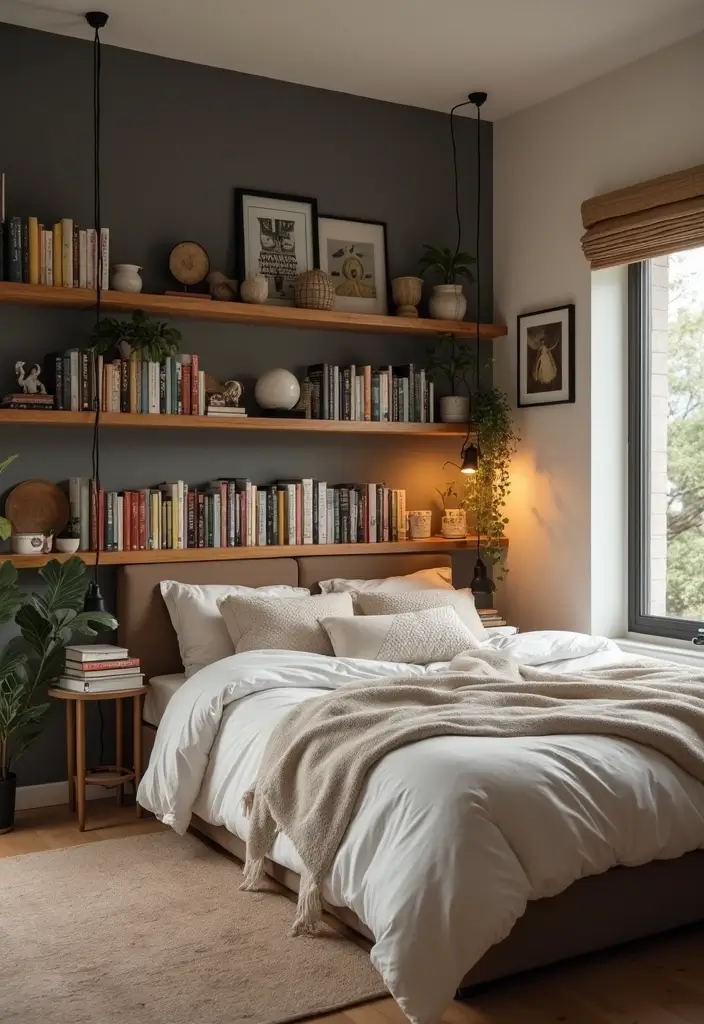
Here is a fresh take on making a shared bedroom feel like home for both of you. You want balance, warmth, and a sense that you both belong here. Personal touches do that well. They show your stories and keep the room from feeling cold. Here is why they matter: they celebrate your journey together and invite comfort every night.
Let’s break it down with simple, doable steps.
– Share a mood board. Gather photos, quotes, and small sketches that fit both styles. Keep it on a wall or a digital frame you both edit.
– Use decorative trays to corral everyday items like watches, keys, and bracelets. It looks neat and makes mornings smoother.
– Create a memory shelf. Display a couple of books, a travel keepsake, a framed photo, or a plant. Rotate pieces monthly to keep it fresh.
– Build a photo wall or mini gallery. Mix sizes and frames. Swap pictures on a regular schedule.
– Add a seasonal corner. Change colors with a few pillows or a small sign. Store extra decor in a box when not in use.
– Start a keepsake jar. Tuck in notes, ticket stubs, or small mementos. Read them together at least a few times a year.
– Choose shared colors and textures. Tie the room with pillows, throws, and curtains in your favorite tones.
– Balance personal items. Put a few things from each person where you can see them, without clutter.
Next steps: pick one idea, set a tiny plan, and try it this weekend.
A shared bedroom is your canvas—fill it with memories and personal touches that tell your unique story. Together, you can create a cozy haven that feels completely like home.
7. Bed Size Matters
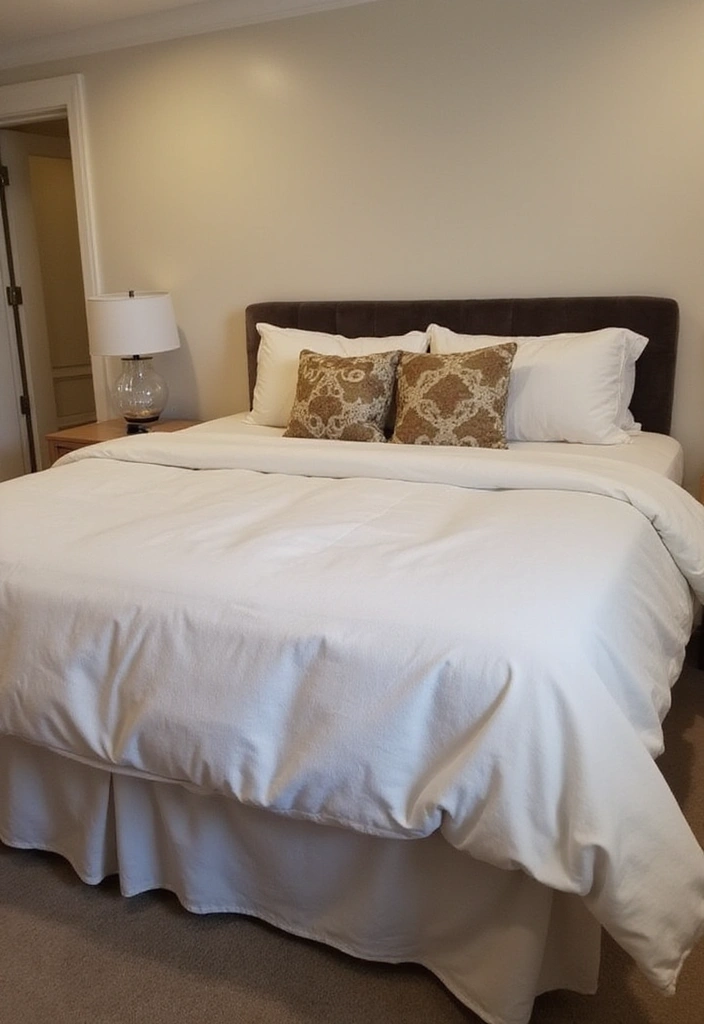
If you share a bed, bed size can change how well you sleep. A bigger bed gives you and your partner room to move without waking each other. If space and budget fit, a queen or king offers real relief from nighttime disturbances.
A larger bed isn’t just about sleep. It invites you to add soft blankets and many pillows, making the bed look cozy and feel inviting. Choose bedding that breathes—smooth cotton or linen keeps you cool and comfy all night.
Here is how to put it into practice:
– Size first: pick a queen if your room is compact; choose a king if you have plenty of floor space.
– Bedding matters: invest in high-quality sheets and a breathable comforter to keep you cool and cozy all night.
– Frame choice: pick a bed frame that fits your style and room.
– Texture and color: layer soft fabrics and balanced hues to blend both styles into a calm, inviting look.
With the right bed size, sleep comes easier and the room stays calm. Add a slim nightstand and soft lighting to finish the balanced look.
8. Zephyr Zones
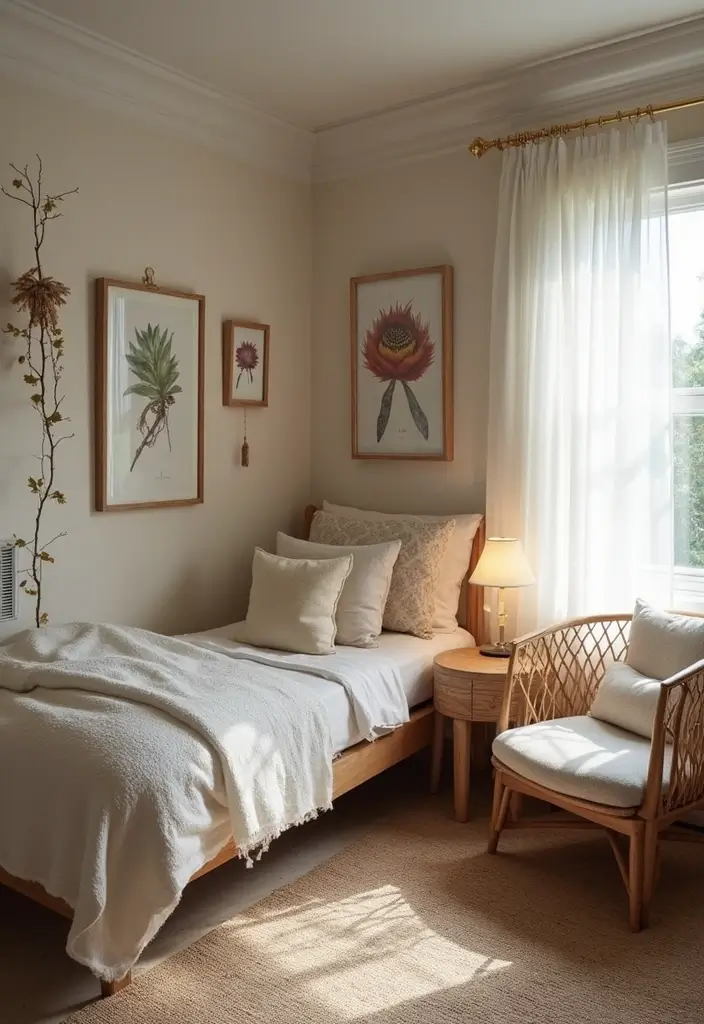
Sharing a shared bedroom can feel crowded. Zephyr zones give you both space to breathe while keeping a warm, cozy mood.
Why Zephyr Zones help You get a sense of ownership without building walls. A defined reading spot, a quiet corner, and a mini work corner make routines easier. Less clutter means more calm.
How to set them up
– Use rugs to map and define zones. A small rug marks the reading nook, a longer runner can run beside the bed for a work area.
– In one corner, place a comfortable chair or a soft bean bag for resting and daydreams.
– Add a desk that fits both styles for shared work moments. Use a simple desk organizer and a cable box to hide cords.
– Create a personal shelf or display in each zone. Let it hold a photo, a plant, or a favorite book.
– Keep each zone tidy with a small tray or basket for essentials. Add a few personal touches so it feels like you.
Next steps
– Measure your space, sketch where zones go, and pull in furniture you already own.
– Pick a blended color palette of warm neutrals with one accent color.
This approach keeps you both happy.
9. Indoor Plants
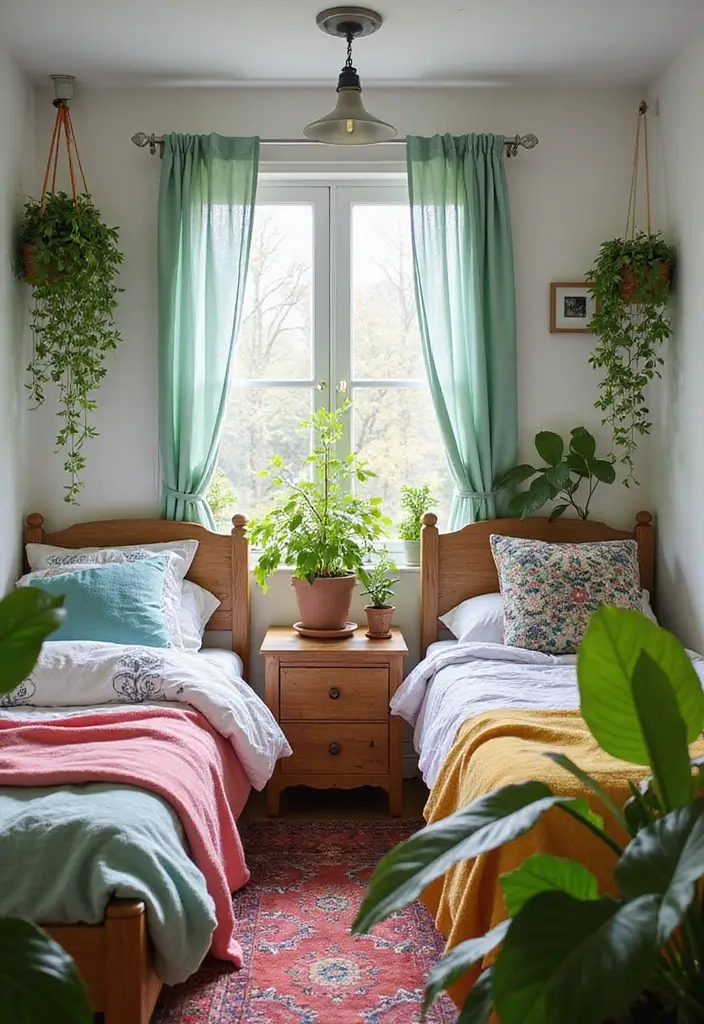
You want a shared bedroom that feels calm, not crowded. Plants can help. They add color, soften edges, and lift your mood. They also freshen the air in a small room. Here is why plant life fits this space: it’s easy to care for and it makes the room feel alive.
Choose low-maintenance options that can handle different light levels. Good picks are pothos, snake plant, and peace lily. They stay healthy with simple care and still look fresh.
– Plant corner Make a small grouping of 2–3 plants on a shelf or beside the bed. A low tray underneath catches water and keeps the surface clean. You’ll notice color and life at eye level.
– Space-saving displays Use plant stands or hanging pots near a window. This keeps floors clear and your nightstands free for reading and rest.
– Windowsill herb garden If the window gets sun, line the sill with compact herbs like basil or parsley. They smell nice and are handy for quick snips.
– Personal touch Pick plants that reflect both you and your partner. A bold leaf plant paired with a softer option makes the space feel shared.
Next steps: choose two easy plants, find a sunny window, and start a simple care routine. Water when the soil dries, wipe leaves occasionally, and rotate pots so they grow evenly. Your shared room will feel balanced and cozy.
Plants aren’t just decor; they’re mood boosters! A touch of greenery in your shared bedroom can create a cozy oasis that breathes life into your space. Choose low-maintenance options to keep it easy and vibrant!
10. Wall-Mounted Solutions
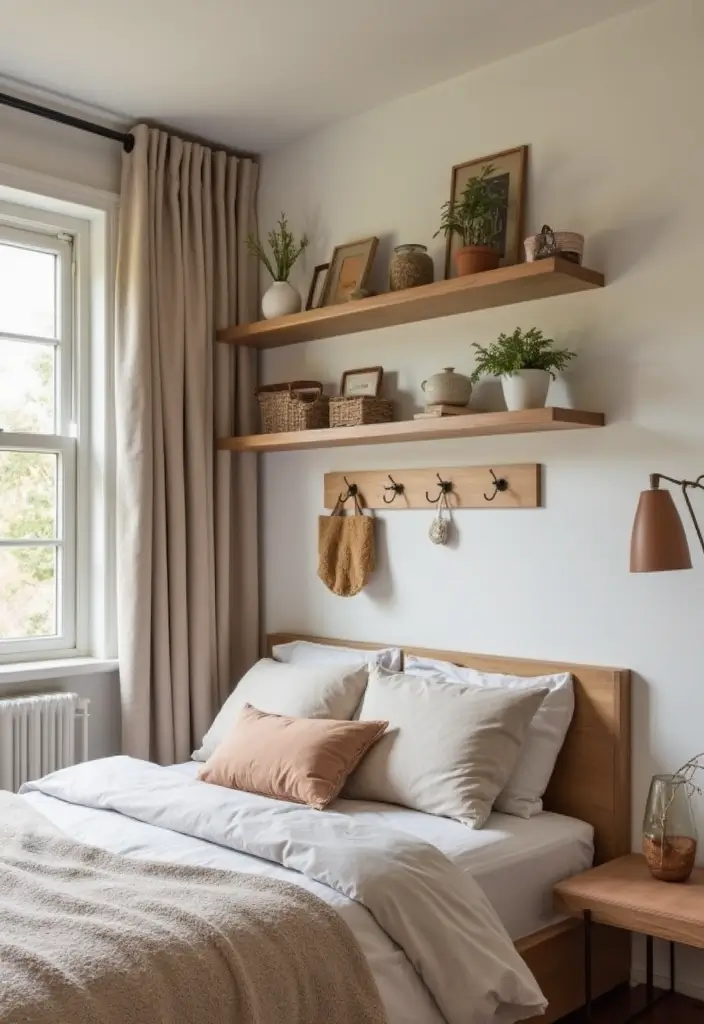
Why wall-mounted setups work in a shared bedroom
You share a room, so every inch matters. Wall-mounted ideas give you space to move. They look clean and calm. They also make room for each person to store personal things without bumping elbows.
Practical ways to use them
– Floating shelves: mount in pairs or solo at a reachable height. Use them for books, plants, or a simple alarm clock. Pick a color that blends with the walls. Keep items light to avoid heavy lifting later.
– Wall hooks: install a row near the door or beside the bed. Use different hooks for bags, headphones, and accessories. Choose a finish that matches your other hardware.
– Wall-mounted nightstand: a slim panel with a small surface feels neat. Add a lamp, a charging cord, and a tiny shelf below. You can reach it easily without crowding the floor.
Tips to install safely
– Check wall studs before drilling. Use proper anchors for weight.
– Keep cords tucked and labeled. Use clips to route cables.
– Respect weight limits. Don’t overload shelves.
Next steps
Measure your wall space. Pick a style and finish. Gather shelves, hooks, and brackets. Mark spots, drill, and mount. Test with light items first.
11. Cozy Bedding Layers
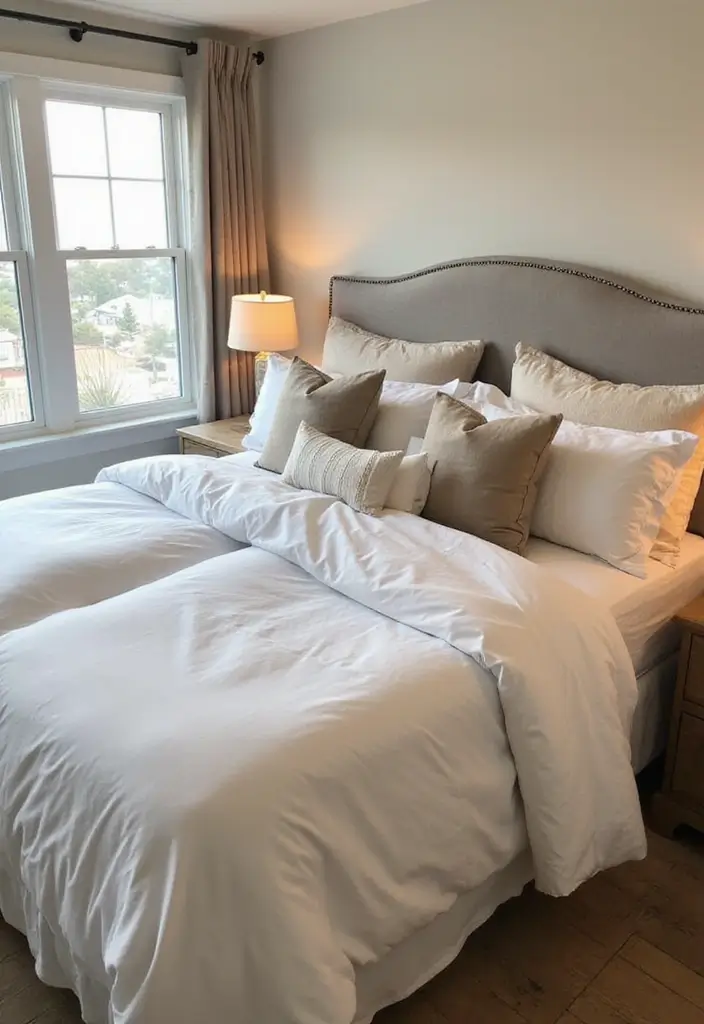
Cozy Bedding Layers
A shared bed should feel warm and calm. Cozy bedding layers help you sleep soundly and keep the room neat. Start with a good mattress, then add sheets, a duvet, and a soft knit throw. Mix textures so the bed looks inviting, not cluttered. A thoughtful mix keeps each side comfy.
Here is how to build it.
– Sheets Choose cotton sheets in a 300 to 600 thread count for comfort and durability.
– Sheet types Percale stays cool in warm weather, while sateen feels softer in cooler nights.
– Duvet and color Pick a duvet cover that matches your color scheme and mood; solid shades feel calm.
– Warmth layer Add a wool blanket or chunky knit throw for extra warmth and texture.
– Seasonal balance Use one heavier layer in winter and a lighter option in warmer months to adapt.
– Draping choice Fold it at the foot or let it drape for easy reach.
– Pillow setup Use 2 to 4 pillows per person and mix sizes.
– Decorative touch Add a few small decorative pillows for color and depth.
– Top layer A lightweight quilt sits over the duvet for softness and a tidy look.
– Care and balance Wash sheets regularly and fluff pillows to keep shape; rotate layers seasonally.
Next steps are simple: rotate the layers so each side wears evenly and adjust with the seasons.
12. Declutter Regularly
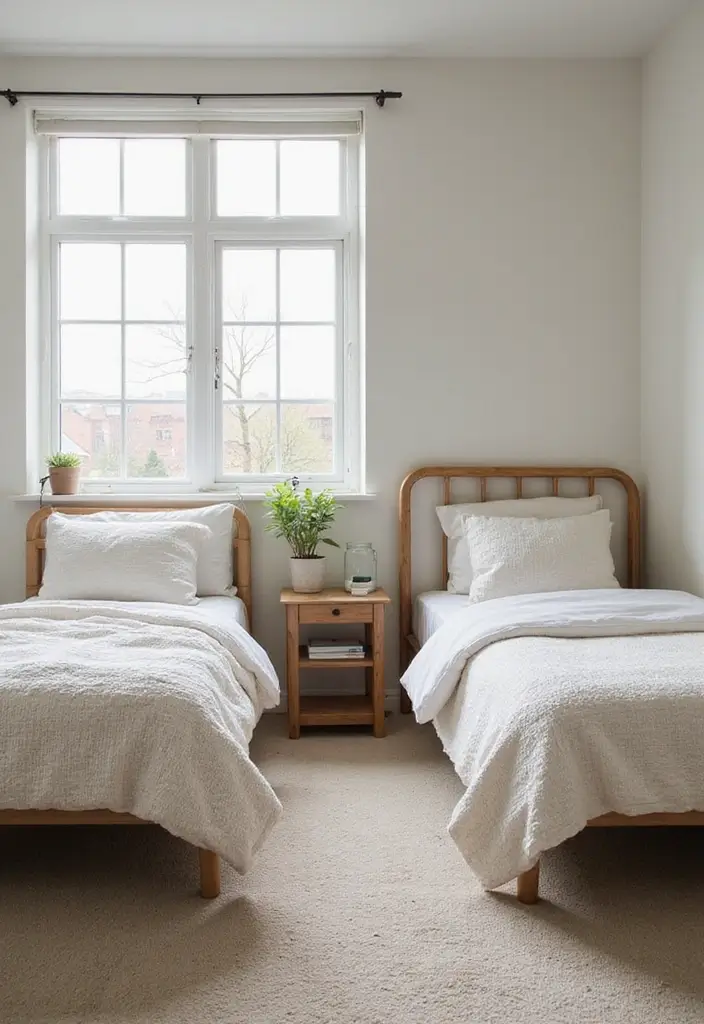
Is your shared bedroom crowded? Clutter drains sleep and peace. Decluttering regularly helps you keep a cozy space both of you can enjoy.
Here is a plan you can follow.
– Schedule a monthly declutter date; spend 15 to 30 minutes tidying.
– Sort belongings into keep, donate, or recycle; ask what truly matters.
– Create a designated space for each partner’s items, such as a small shelf.
– Use baskets, bins, or boxes to corral items on shelves or under the bed for quick access.
– Turn decluttering into a quick, fun activity by playing soft music and keeping a light pace.
– Only display things that spark joy; tuck away extras and keep surfaces clear for a calm vibe.
– Add vertical storage ideas like shelves, hooks, and under-bed boxes.
– For keepsakes, pick a small memory box so a shelf stays neat yet holds memories.
While you do it, notice how light fills the room and how easy it is to clean a nightstand. The right containers keep items off surfaces and make resets fast. Start with a small corner, then move to another shared area.
Here is why this routine works: it clears desks and nightstands, frees space for sleep, and helps you keep routines.
Next steps: pick a date this month and begin with one small area, like a dresser top.
13. Cozy Reading Nook

You want a personal space in a shared bedroom. A cozy reading nook gives you quiet time without leaving the bed area. It offers a small retreat you can use every day.
Choosing the right spot
– Pick a corner, a window seat, or a spot by the wall where you can sit comfortably.
– Use a chair you like or a bean bag that feels soft and inviting.
– Add a low table for drinks, a book, or your phone.
Make it feel calm
– Add cushions, a warm blanket, and a soft rug to soften the floor.
– Use warm lighting like a small lamp or string lights that create a gentle glow.
– Place a few low-maintenance plants for fresh air and color.
Practical touches
– Hang a tiny shelf nearby for quick access to your current reads.
– Keep a storage basket for magazines or notebooks.
– Choose fabrics in a calm color that matches the room.
Tips to keep it tidy
– Sit near natural light but avoid glare on pages.
– Fold or swap cushions every few weeks to keep them fluffy.
– Clear the table at the end of the day so the corner stays inviting.
Next steps: try this setup this week and tweak it. Your personal reading nook can grow with the room.
Make it yours and enjoy daily.
14. Strategic Storage Solutions
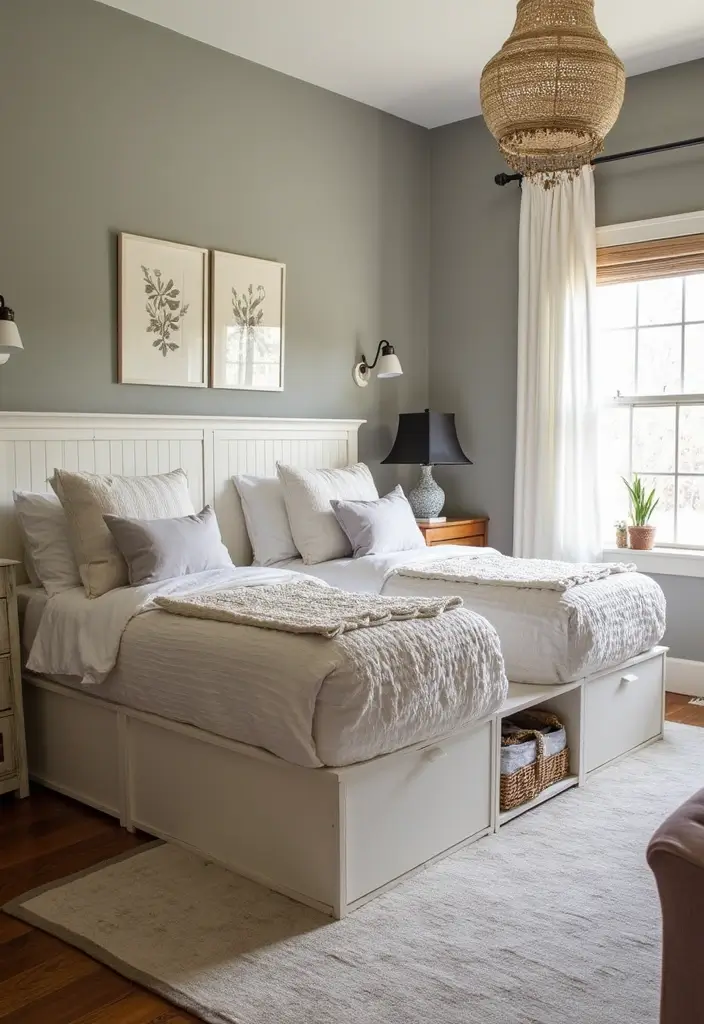
Are you sharing a bedroom and feel like there is never enough storage? You can fix that by turning storage into a calm part of the design. These ideas keep items tucked away while adding style you both will love.
– Built-in storage options. Pick a bed with drawers or a storage bench at the foot. These pieces hide daily items and keep the floor clear.
– Under-bed storage. Use flat bins or rolling drawers to tuck seasonal clothes, shoes, or extra blankets out of sight.
– Baskets and decorative boxes. Place matching baskets on a shelf or a simple trunk to hold blankets, books, or cables. They bring texture and warmth.
– Vertical storage and walls. Install slim shelves and sturdy hooks. A peg rail or over-door organizer gives a place for bags, hats, and chargers.
– Closet zoning. Add a few slim organizers, hanging shelves, and labeled bins. It creates clear spots for each person’s things.
– Multi-functional furniture. A bench with a lid or a small fold-out desk adds seating and hidden space for linens or work gear.
– Smart labeling and daily use. Label boxes or bins so you grab the right item fast. Keep a small daily bin for items you reach every day.
These moves work with many styles, from clean minimalist to warm, cozy vibes. With the right setup, shared space stays neat and inviting.
15. Themed Decor

You’re sharing a bedroom and want it to feel balanced and cozy. Themed decor helps you connect without fighting over style. It gives you a clear look and easy steps.
Here is why it works: you both see your interests reflected, the room stays organized, and small changes can make a big impact.
– Choose a theme you both love. Talk about two things you enjoy – like travel and nature – and pick a simple link between them. A clear idea makes the room feel intentional.
– Set a calm color palette. Pick 2–3 colors that fit the theme. Use them on walls, bedding, and accents to keep the space harmonious.
– Use wall art and textiles. Framed maps, nature prints, or posters from a favorite movie add character. Tie pieces together with the same color accents.
– Add practical decor ideas. Create a vision board for future trips and hobbies. Place a small shelf with books that match your shared interests.
– Keep it flexible. Let the decor shift with seasons or trips. Swap out a pillow cover, swap a poster, or change a souvenir.
Next steps: start small. Pick one element to refresh this week—bedding, wall art, or a shelf. Set a tiny budget and enjoy co-creating.
16. Mood Boards
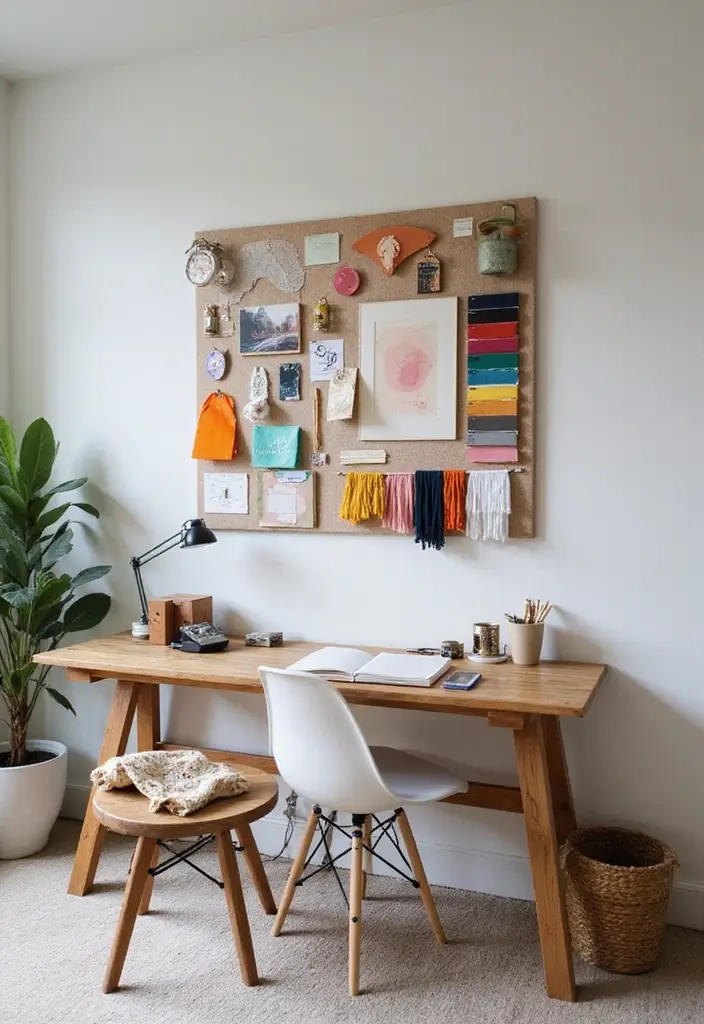
Are you trying to blend two styles in a shared bedroom? A mood board can bring balance without a big fight over taste. You both add ideas, and the board shows the spot where your rooms meet. This keeps your space calm and warm.
Here’s how to do it.
– Choose a spot: a corkboard on the wall, a pin board, or a digital mood board on a tablet.
– Gather items: color swatches, fabric samples, photos, magazine cutouts, and textures like cotton, linen, or velvet.
– Build the board: lay out items by vibe, then add notes about what you like about each piece.
– Create a palette: pick 2–3 main colors and 1 accent color.
– Use it while shopping: bring the board to pick furniture, bedding, and wall decor.
– Update it: add new finds as you discover styles you love.
– Display: pin it on the wall or keep a digital version you can scroll.
Why this helps: it guides decisions, saves time, and keeps your room looking like both of you.
Next steps: set aside 20 minutes today to start. Schedule a 15–minute monthly refresh to keep ideas fresh.
This keeps the mood steady as seasons change. You can do it in parts.
17. Seasonal Changes

Seasonal Changes
You want the shared bedroom to feel fresh without big buys. Seasonal decor can do that. It changes the mood with color, texture, and small details. Fall brings warm tones and soft throws. Summer calls for light linens and airy accents. Winter invites cozy touches and simple festive pieces. Spring gives you fresh greens and gentle pastels.
Here is why this works: it lets both partners shape the space. You both add ideas, and you both notice the space more.
– Start with a seasonal decor box. Put in a few art prints, a pillow cover, a throw, and any small items that fit the season.
– Mix pieces you keep year-round with items you swap. A sturdy bedspread stays, while pillows and wall art rotate.
– Set a simple rotation plan. Pick a date each season to swap a couple of items or switch up one focal piece.
– Invite ideas from your partner. Ask, “What color or texture would feel right this season?”
– Try real world color combos. Fall: deep orange and cream. Winter: chocolate, red, and soft white. Spring: sage green and pale pink. Summer: white, seafoam, and light wood tones.
Next steps: pull your seasonal box together this weekend and pick your first swap move.
18. Natural Materials
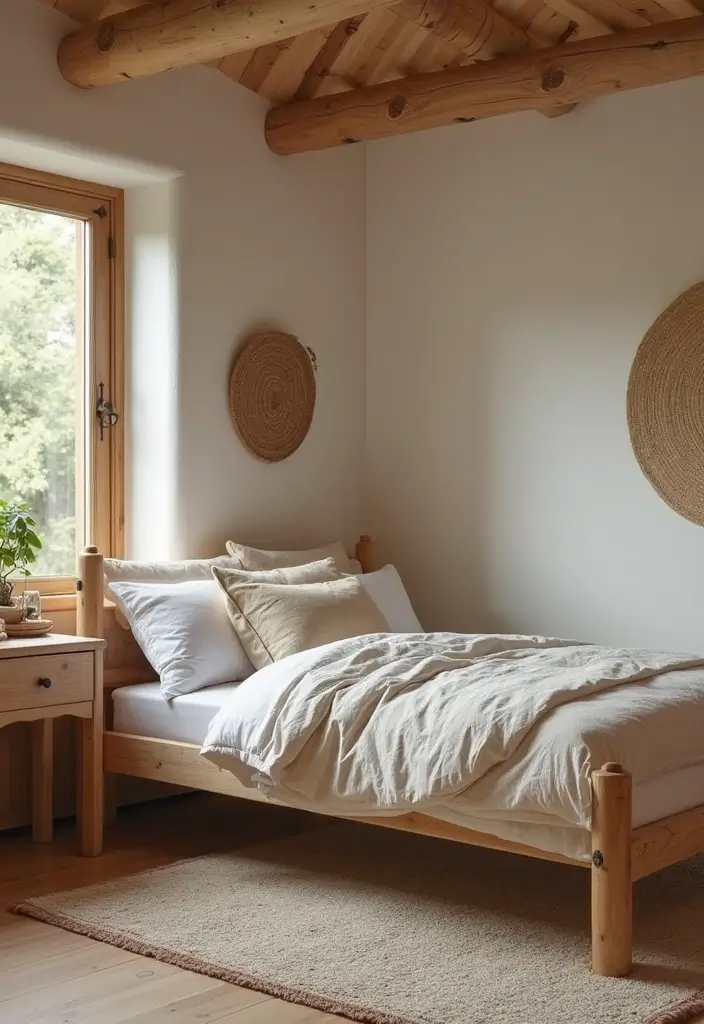
You want a shared bedroom that feels calm and cozy. Natural materials can help you get there. Here is why natural options fit a couple space.
Best picks to start
– Choose a wooden bed frame for a warm, timeless base.
– Pick cotton sheets and a duvet for breathable comfort.
– Add stone or clay accents like a vase or lamp for texture.
Putting it together
Mix textures to add depth. A wooden frame with a soft cotton duvet feels cozy. Pair it with a wool rug and a clay planter to balance look and feel. Keep colors earthy, with browns, creams, and sage.
Sourcing and care
– Look for sustainably sourced wood to lower impact.
– Choose organic cotton or linen for bedding.
– Pick low-VOC finishes on furniture and natural paints for accents.
Keep it simple by caring for materials regularly. Dust wood weekly and air out fabrics after use. Wash cotton sheets in warm water and tumble dry on low. Talk with your partner about textures you both love, and adjust over time.
Natural materials make a shared space feel balanced and inviting. They pair well with other ideas in this guide and stay comfortable without overpowering the room. If you start with a wood base, breathable textiles, and earthy decor, you set a calm, cozy tone that lasts.
19. Cozy Throw Blankets
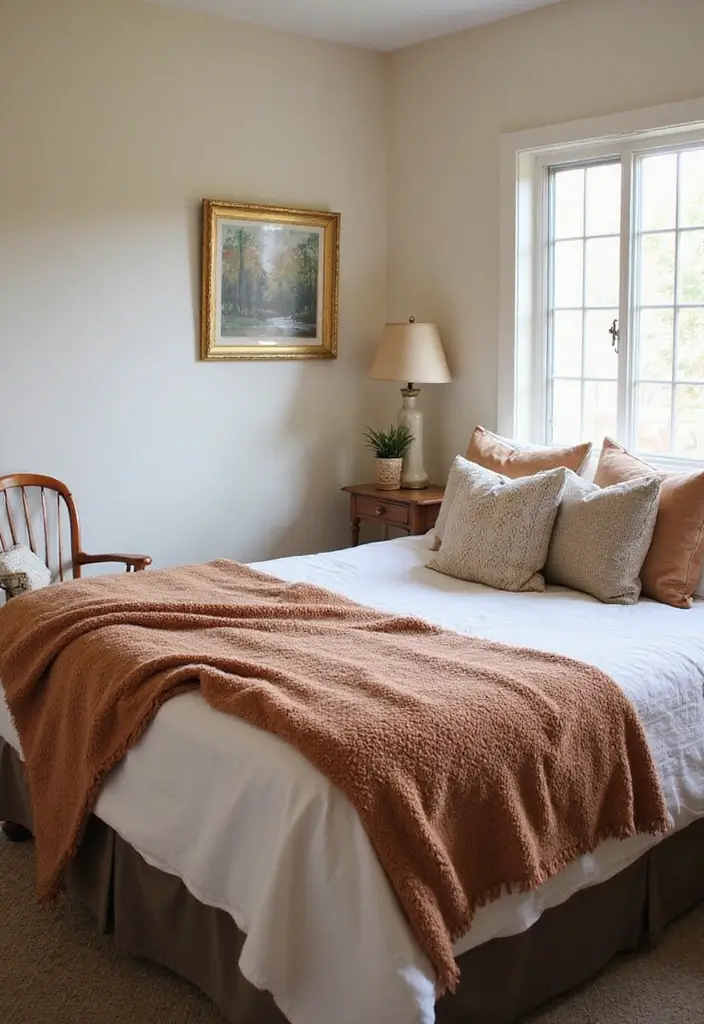
Sharing a bed means you need small touches that work for both people. Cozy throw blankets can do that quickly. Here is why they help and how to use them well.
– Choose soft, easy-care fabrics
Pick throws that feel good to touch and are easy to wash. Cotton blends or lightweight wool blends are great choices.
– Mix textures for depth
Pair a chunky knit with a smooth cotton blanket. Different textures catch light and add warmth without crowding the space.
– Color and pattern balance
Match throws to your room’s palette. If the bed print is bold, go calmer with the throws. If the bed is plain, a brighter accent throw adds interest.
– Placement that signals balance
Drape one throw at the foot of the bed and keep another on a chair or ottoman. This creates visual symmetry and quick access.
– Care and rotation
Rotate throws with the seasons. Store extras in a basket to keep the room neat and inviting.
Next steps
Choose two or three throws that fit your shared style. Layer them this weekend and adjust as you live with them.
20. Soft Area Rugs

Soft Area Rugs that Balance a Shared Bedroom
Soft area rugs make a shared bedroom feel warm and balanced. They cushion steps and define zones around the bed and seating. Choose a plush rug that fits your color mood and room size.
– Size and placement – Choose a rug large enough to sit under the bed and nightstands for a pulled-together look. If space is tight, add a long rug along the bed to anchor the room.
– Materials – Look for a plush feel and easy care. Wool adds warmth, but costs more; synthetics last and resist stains. Cotton blends stay soft and breathable.
– Color and pattern – Pick colors both people enjoy. A solid tone hides wear and matches many sheets. A soft pattern adds texture without shouting.
– Layering for depth – Layer rugs to add depth. Place a large flat rug under the bed and add a smaller one on top. A sheepskin adds a cozy touch.
– Safety and upkeep – Use a non-slip pad to keep the rug in place. Vacuum weekly and spot-clean spills right away.
– Practical steps – Next steps: measure space, compare rug sizes, and check care labels. Weigh cost against upkeep to avoid regrets.
With the right rug, both of you feel grounded when you wake.
21. Thoughtful Organization
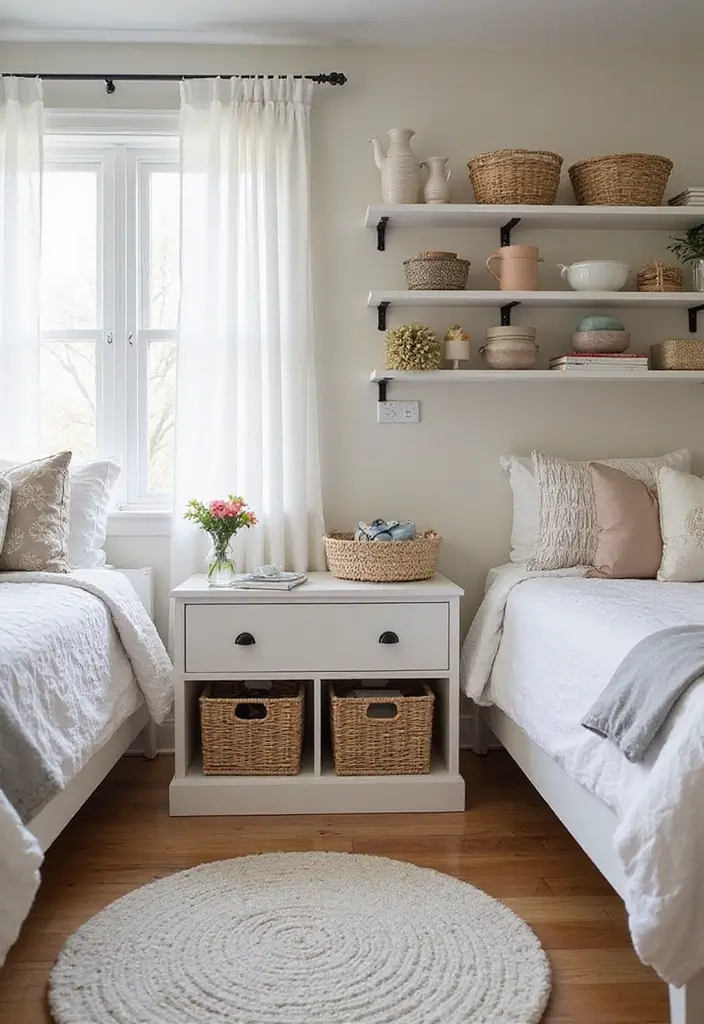
You want a shared bedroom that feels calm and easy to live in. Good organization makes that possible. With a simple system, both of you can find what you need fast. You’ll keep clutter down and daily routines stay smoother.
– Pair storage for unity. Choose matching baskets, bins, and drawer dividers. Use a single color or material like smooth wood or soft fabric. That cohesion helps the room look tidy even with two people living in it.
– Label and separate. Put a clear label on each bin or drawer. A quick note or tiny tag keeps items in the right place. On busy mornings, this cuts questions and saves you minutes.
– Eye-level access. Put items you reach often at eye level on open shelves or the front of drawers. Daily essentials like chargers, sunglasses, and a notebook stay easy to grab.
– Zone design. Split the space into small zones: clothes on one side, personal care on another. A shared tray for keys and a jewelry box on a dresser edge helps view and reachability.
– Regular quick edits. Do a 5-minute tidy once a week. Remove what you don’t use, and rebalance space so both partners feel at home.
Next steps: pick a storage spot, grab a pair of matching baskets, label what goes where, and test the setup for a week. You’ll know fast if you need tweaks.
A well-organized shared bedroom is the secret to harmony. With thoughtful storage and clear labels, you’ll create a peaceful retreat that feels like home for both of you!
22. Vintage Charm

You want a shared bedroom that feels balanced and cozy. Vintage charm can help you get there without making the room crowded. You can mix old pieces with new ones to keep the space calm and useful.
Here is why it works. A few well chosen items add warmth without chaos.
– Pick one vintage anchor piece, like a dresser with history or a lamp that glows softly.
– Pair that piece with clean, modern essentials so the old item fits in.
– Add a couple of vintage inspired touches that are easy to switch, such as retro artwork or a small clock.
– Mix finishes to keep the look interesting, not busy; worn wood sits well with smooth metal.
– Use soft lighting to tie the room together and create a cozy mood for late evenings and early mornings.
– Display memories in a simple way, with a small gallery or a shelf of favorite trinkets.
Next steps: visit thrift stores or flea markets for hidden finds. Check that each piece is sturdy and clean before you set it up. Rotate items with the seasons to keep the shared space fresh.
Be patient as you swap items. Balance grows with time. Soon the room feels right.
23. Breezy Curtains

Shared bedrooms can feel cramped. You want light, privacy, and calm. Breezy curtains help you reach that balance. They soften glare and let sunshine drift in.
Here is why they work:
– Light fabrics that drape well keep the room airy.
– Sheer neutrals add warmth without heavy blocks of color.
– A second layer gives privacy when you need it.
How to set them up:
– Choose fabrics like cotton gauze, linen, or voile. These stay light and handle daily use.
– Pick neutral colors such as white, cream, soft gray, or warm taupe. They blend with most decor.
– Layer two panels: a sheer in front and a blackout or thicker panel behind for privacy and night use.
– Install a curtain rod that suits your style and can handle multiple layers.
– Mount the rod high and wide. This makes the window feel larger and the ceiling higher.
– Use clips or ties to pull curtains back on sunny days and let the light flood in.
Care and style tips:
– Keep patterns simple so both beds feel calm.
– Match metal or wood tones to other window treatments in the room.
– Check care labels; most breezy fabrics wash gently.
Next steps:
Measure your windows, shop light fabrics, and plan two-layer panels for flexibility.
Breezy curtains can transform your shared bedroom into a tranquil oasis! Let the light in while maintaining your privacy—it’s the perfect balance for a cozy, minimalist retreat.
24. Scented Accents

Scent can help a shared bedroom feel calm. If your space smells off, a few scented accents can fix it without loud notes. You want aromas that soothe both people.
Here is why scent matters: a gentle aroma slows you down and signals rest. It can ease stress after a long day.
How to use scent the right way:
– Pick two calm scents you both enjoy, like lavender with vanilla or linen with citrus.
– Choose one main source to carry the scent.
– Place scents away from the bed on a dresser so they spread evenly.
– Start low and adjust slowly. If it seems strong, turn it down or switch to a lighter aroma.
Ways to keep it fresh:
– Rotate scents by season: spring florals, fall woods.
– Use decor-friendly containers: ceramic diffusers, glass bowls, or fabric sachets.
– Layer gentle notes rather than stacking heavy ones.
Tips and limits:
– If someone is sensitive, keep scents faint or skip for a week.
– Clean diffuser pads or candle jars regularly.
– Let the room breathe by opening a window now and then.
Give one combo a week. If it works, keep it. If not, switch to lavender plus linen.
25. Shared Experiences

Your shared bedroom should feel like both of you. Shared experiences give it life. They make the room warm and calm.
Here is why you should add memory moments to your space. They build belonging. They also spark easy talks and daily comfort.
– Memory wall: Choose a wall or corner. Use frames, a photo grid, or a simple string with clips. Pick a calm color scheme and add small captions with dates or notes. Rotate items every few weeks to keep it fresh. Soft lighting helps the wall glow.
– Shared journal: Keep a small notebook on the bedside table. Each night, write one line about a memory or a feeling. You can draw a tiny doodle or jot a quick thank you. If you both write, swap pages weekly.
– Decor that shows both of you: Pick keepsakes from trips, favorite books, or crafts you made together. Display them on a shelf or corkboard. Let items share a common color or theme so the space feels calm, not cluttered.
– Make it a habit: Set a 10-minute memory check-in once a week. Look back, pick a new photo to add, or plan a tiny future moment.
– Practical tips: Save photos in a shared cloud so you can print them monthly. Label keepsakes and keep the display tidy. This keeps the room balanced and easy to enjoy.
Start small. Pick one idea this weekend, and watch the room feel more like your shared story.
Conclusion
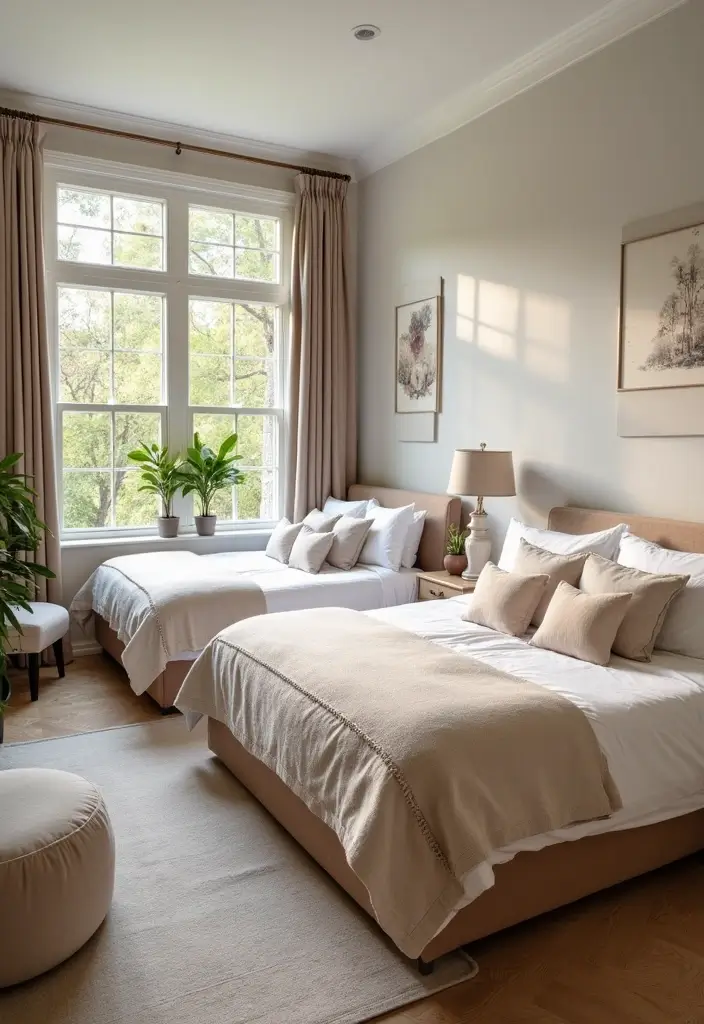
Creating a balanced and cozy shared bedroom is all about blending styles and ensuring that both partners feel at home. By embracing thoughtful decor choices, layering textures, and incorporating personal touches, you can create a sanctuary that reflects your unique relationship.
Let your shared space be a reflection of your journey together, a place where comfort meets style. Embrace the ideas shared and start crafting the perfect cozy retreat!
Frequently Asked Questions
What are some effective color palettes for a cozy shared bedroom?
When creating a cozy atmosphere in a shared bedroom, consider starting with a harmonious color palette. Neutral tones like soft white, warm gray, and muted green work beautifully to set a soothing stage. You can then add accent colors that reflect both of your personalities, creating a space that feels calm and personalized.
Mixing in some subtle textures can enhance the overall vibe, ensuring that both partners feel at home.
How can multifunctional furniture help maximize space in a shared bedroom?
Multifunctional furniture is a game-changer for shared bedrooms! By choosing pieces that serve multiple purposes—like a bed with built-in storage or a desk that doubles as a nightstand—you can keep the room feeling balanced and cozy without overcrowding it.
This thoughtful approach allows you to maintain floor space for movement while minimizing clutter, making your shared space more enjoyable for both partners.
What are some tips for incorporating personal touches in a shared bedroom?
Incorporating personal touches in a shared bedroom can make the space feel uniquely yours! Consider adding shared wall art that reflects both of your tastes, or displaying meaningful items from your relationship. You can also create a cozy reading nook with cushions and blankets that both of you enjoy.
These details will foster a sense of belonging and warmth, ultimately turning your shared bedroom into a sanctuary that celebrates your connection.
How can I keep my shared bedroom decluttered and organized?
Decluttering is essential for maintaining a cozy shared bedroom. Start by scheduling regular decluttering sessions—maybe monthly—to keep chaos at bay. Utilize strategic storage solutions like under-bed bins or wall-mounted shelves to keep belongings neatly tucked away.
Establishing a simple organization system will ensure that both partners can find what they need quickly, making the shared space feel more serene and inviting.
What lighting options create a cozy atmosphere in a shared bedroom?
Lighting plays a crucial role in setting the mood of your shared bedroom. Opt for soft lighting solutions like bedside lamps with warm bulbs or fairy lights to create a calming ambiance. Layered lighting can also be effective—mixing overhead lights with softer sources will help you achieve a cozy, inviting atmosphere.
Switching to dimmers can allow you to adjust the brightness based on your activities, whether it’s reading, relaxing, or winding down for sleep.
Related Topics
shared bedroom ideas
cozy decor
minimalist design
harmonious layouts
adult bedroom decor
multifunctional furniture
soft lighting
personal touches
stylish shared spaces
easy organization
layered textures
seasonal decor

